It’s bulb planting season, and already we’re dreaming about spring landscapes awash with colorful blooms. Before we rush to plant our crocuses, daffodils and tulips, which have no evolutionary history with our native insects, consider early-blooming natives that hungry, freshly emerged pollinators will recognize and use.
Let’s look at some native spring ephemerals that grow in bright spring woodlands. We can use them in many of our shady to sunny borders where other emerging plants will replace them once the season heats up.
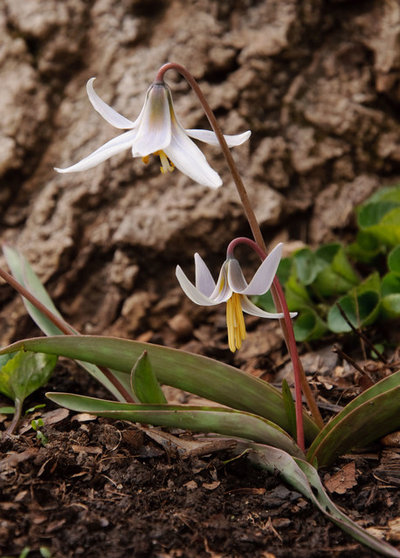
Barbara Pintozzi
White Trout Lily(
Erythronium albidum)
Native from Minnesota and Nebraska south to Texas, east to Alabama in the south and New York in the north
Trout lilies are ephemerals that take a few years to bloom. They prefer medium-dry to moist, rich woodland soil. White trout lily, also called white fawnlily, and yellow trout lily reach about 6 inches tall and slowly spread, with an army-like camouflage of maroon and green to silver and green on their leaves. This leaf design makes them harder for herbivores to see and eat.
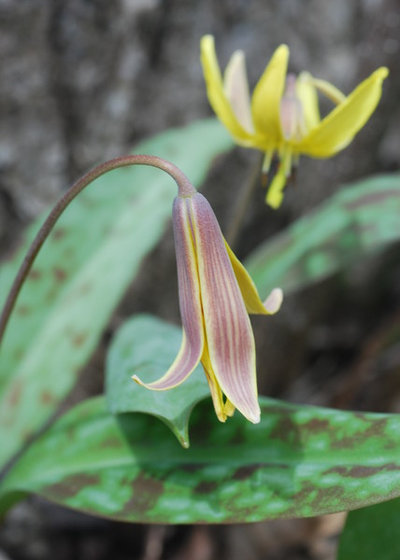 Yellow Trout Lily
Yellow Trout Lily(
Erythronium americanum)
Native from Minnesota to Missouri, southeast to Alabama and Georgia, and north to Maine
Yellow trout lily, also called dogtooth violet, and white trout lily slowly produce more blooms each season, with individual flowers lasting only a few days. Both make a great spring ground cover and serve as an important food source for spring-emerging pollinators like queen bumblebees, mason bees and andrenid bees. Other bees you might find include cuckoo, digger and halictid.
Look for plants in the
Erythronium genus that are native to other parts of the country, including
E. californicum in Northern California and
E. revolutum,
native from southern British Columbia to California.
Light requirement: Dappled light (full sun in spring as trees leaf out is perfect), or a 50/50 sun and shade mix, avoiding afternoon sun
Mature height: About 6 inches tall and slowly spreads
Planting tips: Put potted plants in the ground in fall or spring in wet to medium-dry loam soil.
Photo by Joshua Mayer
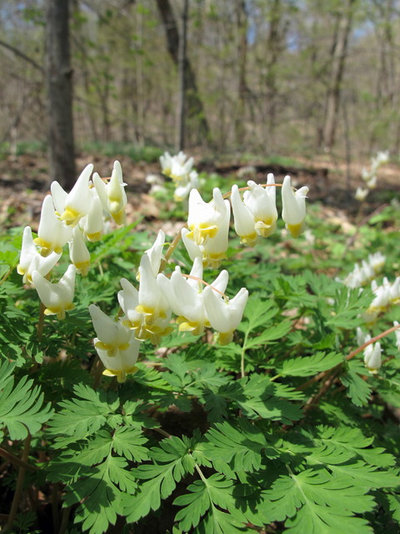 Dutchman’s Breeches
Dutchman’s Breeches(
Dicentra cucullaria)
Native from the eastern Dakotas south to eastern Oklahoma, all the way to northeast Georgia and into Maine; also found in the Pacific Northwest
Often found growing in undisturbed areas along slopes, ravines and streams, Dutchman’s breeches begins blooming in early spring, with bright white flowers that resemble upside-down “V”s or Dutchman’s breeches. The attractive leaves resemble those of a geranium-meets-rue and turn yellow once the flowers have gone to seed in early summer.
Dutchman’s breeches prefers loam soil. While ants are the primary seed spreaders, you’ll find bumblebees and mason bees pollinating Dutchman’s breeches, with occasional visits by butterflies. Caution: All parts of this plant are poisonous.
Light requirement: Full shade or dappled sun
Mature height: 12 inches tall
Planting tips: Plant potted plants in fall or spring in somewhat rich, well-drained loam soil.
Photo by Kristine Paulus
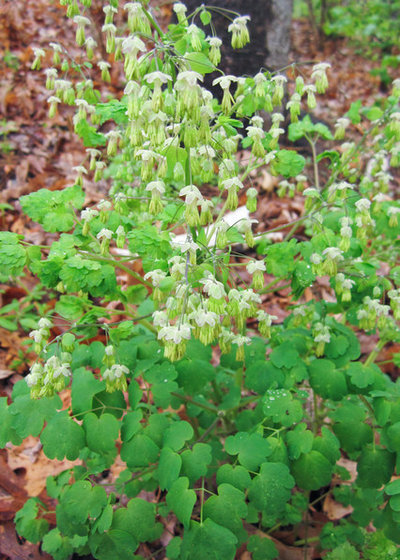
Holm Design & Consulting LLC
Early Meadow-Rue(
Thalictrum dioicum)
Native from Minnesota south to Arkansas and Mississippi, east to Georgia in the south and Maine in the north
Early meadow-rue flowers might be subtle, but the foliage adds a textural punch through summer (even if the leaves are the size of dimes and nickels). The female flowers are very small, and the male flowers dangle upside down like lanterns.
You won’t see many pollinators on early meadow-rue, since it’s mainly wind-pollinated, but it is a very adaptable spring plant that doesn’t need rich soil, like so many other woodland species.
Light requirement: Shade to partial sun
Mature height: About 1 foot to 2 feet tall and wide
Planting tips: Put potted plants in the ground
in spring or fall.
Male and female flowers appear on different plants, so be sure to purchase several plants so you have both (male flowers are shown here).
See how to grow early meadow-rue
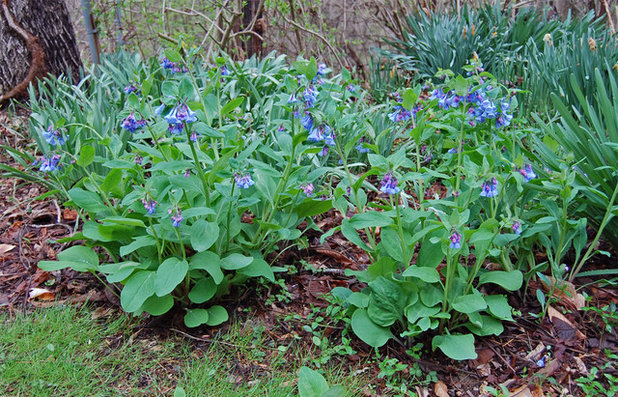 Virginia Bluebells
Virginia Bluebells(
Mertensia virginica)
Native from Minnesota east to Virginia and New York, and south to Arkansas and Mississippi
Virginia bluebells puts on a show each spring, with bell-shaped flowers appearing after new shoots of tightly curled leaves appear. Due to the flower shape, bumblebees and other long-tongued bees are some of the only pollinators that can reach Virginia bluebell’s pollen and nectar. Sphinx moths and other hummingbird moths visit the bell-shaped flowers as well. This plant is a moderate spreader in medium soil that’s fairly rich and fertile, and will spread faster in moist soil.
If you’re in the Pacific Northwest, look into tall bluebells (
Mertensia paniculata); if you’re in the Southwest, look into aspen bluebells (
M. arizonica).
Light requirement: Dappled sunlight to a 50/50 sun-shade mix
Mature height: 1 foot to 2 feet tall in bloom; spreads slowly
Planting tips: Put potted plants in the ground in fall or spring in moist to medium loam soil. The wetter the soil, the more sunlight they can take (and then the more blooms you’ll get).
See how to grow Virginia bluebells
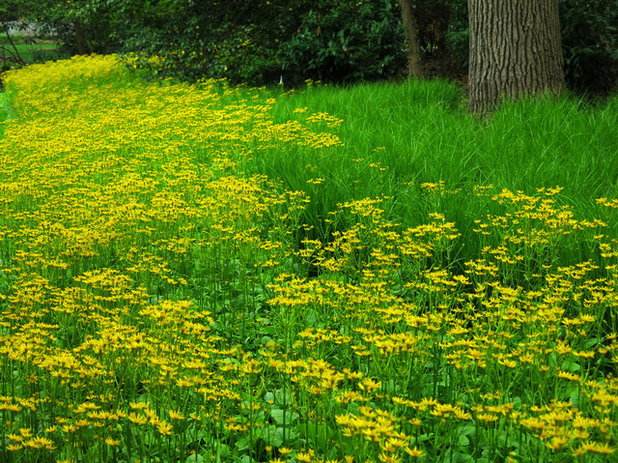
Donald Pell - Gardens
Golden Ragwort (
Packera aurea)
Native to the eastern U.S., from Minnesota south to Texas and all parts east
Gold ragwort’s low clump of large leaves makes up half of its height, while the other half is composed of yellow flower clusters on wiry stems. This plant prefers woodlands, river and lake edges, moist meadows, rocky glades, sandy swamps and medium-dry woods.
Short-tongued pollinating insects, such as carpenter and cuckoo bees, visit this flower, as well as many fly species. You’ll also find its foliage resistant to many herbivores.
Golden ragwort self-sows freely in optimal conditions
, which may be a concern in a small garden. But sometimes aggressive plants in their native regions can be a very good thing.
Light requirement: Shade to sun; needs more moisture and richer soil the sunnier it gets
Mature height: 1 foot to 2 feet tall
Planting tips: Put potted plants in the ground in fall or spring in a loam soil.
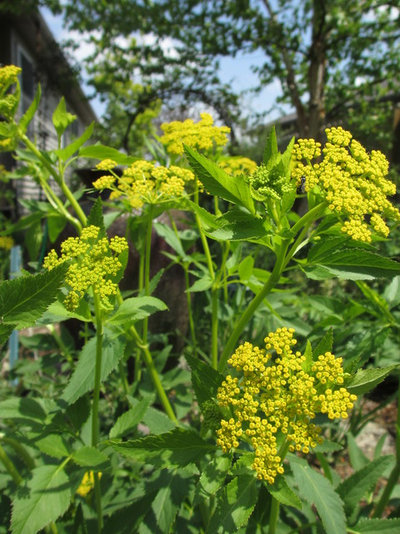
Benjamin Vogt / Monarch Gardens
There are many additional choices that bloom from early spring to early summer and support more pollinators than tulips or daffodils, all while giving our gardens a lush sense of place and region year after year without needing to be fertilized, dug up or replenished. Some of these plants are ephemerals, some are bulbs, and others are standard full-year perennials.
Tell us: Have you planted early-blooming native plants in your garden? Share photos in the Comments below.





